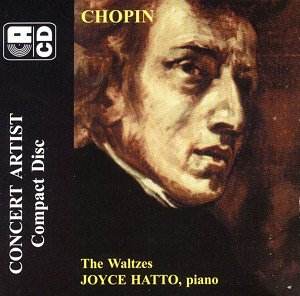This is Volume 7 in Joyce Hatto’s monumental
Concert Artist series of the complete Chopin piano works.
It’s axiomatic that comparison between two artists
will produce compelling points of divergence but it was most instructive
to listen to her set alongside the paradigmatic Rubinstein traversal
of 1963. In the first, the E flat major, one finds that Hatto
relaxes more into the contrasting central section than does Rubinstein
who is more lithe and excavates a bewitching variety of puckish
voicings. Hatto’s rubato is more pronounced, speeding up and slowing
down, those repeated hammer notes of subtly different speed and
depth; she caresses more, unlike Rubinstein, whose momentum is
straighter; whose line is more undeviating. In the A minor, Op.34/2
we find Rubinstein wistful, espousing recollection in tranquillity
if tinged by regret. Hatto is considerably slower but the differences
between them are not simply ones of tempo because she phrases
and colours and inflects the line with constant rhythmic hesitancies;
in her hands the mood is one of nostalgic reflection.
In the F major (No.34/3) Rubinstein piles on
the colour and crisp accents and humorous voicings (some might
find him just too overtly perky here) whereas Hatto makes the
very most of contrastive material whilst inflecting through rubato
usage. She maintains splendid clarity of passagework in the A
flat major Op.42, relaxing into the central section and then building
to a tremendous climax rather more successfully than Rubinstein.
In the D flat major from the Op.64 set I find that Rubinstein
binds the rhetoric rather more cohesively than she does though
there are many points of interest in the C sharp minor. Rubinstein’s
pointing toward the end is supreme here but earlier we can hear
how Hatto varies the tempo, employing subtle rubati underpinned
by an absolute digital control – excellent passagework. Her sonorities
sound entirely natural and she is a deeply sensitive exponent
of these works sustaining here an air of almost perplexed direction
that is unsettling and thought provoking. In the A flat major
Op.69/1 we again find Rubinstein more obviously ardent, more projective,
kaleidoscopic in his quicksilver emotive responses and also his
ever-present humour. Joyce Hatto employs rubato with considerably
more freedom and doesn’t engage in the kinds of puckish voicings
that the older musician did; hers is a more evidently interior
reading. Sometimes her rubati can seem intrusive – I’m thinking
of the B minor Op.69/2 – but her deep identification with and
projection of the musing central panels of these waltzes can again
be admired in the G flat major Op.70/1. Here this section is very
dreamy and reflective and full of tonal allure and affection.
This is a terrifically difficult waltz and she evinces powerful
command – even Rubinstein smudges a run and I don’t know how many
retakes he had – but on balance he binds the piece more wholly
with no loss of affection. In the posthumous F minor the tables
are turned. Hatto is the quicker, Rubinstein the more pensively
private, Hatto the more heroically public, whereas in the E minor
Op.posth Hatto is not as dramatically powerful or as leonine as
Rubinstein, who drives the waltz with magnetic drama. She is lyrical
and affecting in the E flat major of 1827 and shines undimmably
in the E flat major Op.posth published in 1840. Here there is
true lyrical tonal beauty with animation and colour held in balance
and the direction of the music revealed with unforced lyric courage.
As a bonus there is the F sharp minor Op.posth provisionally dated
to 1835. Joyce Hatto’s notes relate the story of an elderly Priest
having given a copy to the publisher Maurice Dumesnil announcing
it to have been by Chopin; authentic or not it’s a charming close
– and you’ll not often hear it played.
Sound quality is natural and pleasing and the
notes welcome and cogent. Volume Seven upholds the fine standard
set by Joyce Hatto in this series.
Jonathan Woolf
Concert
Artist complete catalogue available
from MusicWeb International
